Discovering and documenting bird species new and old, Esha Chaudhuri unearths a life changing experience of connecting and bonding with birds during a walk.
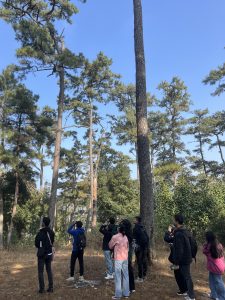 What does one anticipate when treading into green forest patches and meadows? An array of trees, grassy pathways and of course, species big and small. Among them, the ones that chirp are the ones that draw heightened interests – for their bountiful colours and features, as well as their alluring mannerisms. Brought to Shillongites, among other cities, India’s biggest Bird-a-thon in 2024 witnessed between February 16 -19, where people participated in a communal experiential event. Sunday Shillong explores the event through the visuals and discoveries made of the avian species and personal narratives shared through the walks.
What does one anticipate when treading into green forest patches and meadows? An array of trees, grassy pathways and of course, species big and small. Among them, the ones that chirp are the ones that draw heightened interests – for their bountiful colours and features, as well as their alluring mannerisms. Brought to Shillongites, among other cities, India’s biggest Bird-a-thon in 2024 witnessed between February 16 -19, where people participated in a communal experiential event. Sunday Shillong explores the event through the visuals and discoveries made of the avian species and personal narratives shared through the walks.
The walk
As described by the Collins dictionary, a birdwalk is “an excursion, usually undertaken as a group with an expert leader, for observing and studying birds in their natural habitat.”
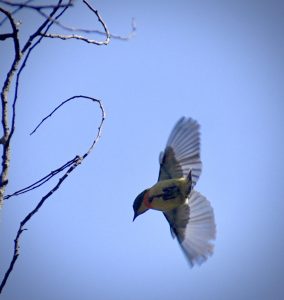 Organised and coordinated by eBird India every year, a global citizen science event was held between February 16-19th, called the Great Backyard Bird Count (GBBC). GBBC in India is coordinated by Bird Count India, an umbrella group of a large number of birding, nature and conservation organisations.
Organised and coordinated by eBird India every year, a global citizen science event was held between February 16-19th, called the Great Backyard Bird Count (GBBC). GBBC in India is coordinated by Bird Count India, an umbrella group of a large number of birding, nature and conservation organisations.
Birding enthusiast and Coordinator of GBBC, Meghalaya, Ezra Lawanker Rynjah who set up the location and time himself, then registered the event with Bird Count India, the overall coordinating institution in India for eBird. The walks and workshops also come under the ambit of Meghalaya Geographic Society, of which Rynjah is a member, which aims to promote responsible exploration and protection of the great outdoors within our corner of the world.
Rynjah has been conducting these walks, introducing the participants to basic birding techniques as well as providing tips for bird identification. Spearheading these walks single-handedly, Rynjah, however, had Dr. Ronald K.L. Tron and Dr. Duwaki Rangad, both faculty members from the Zoology Department of St. Edmund’s College conducting campus walks and even took his (Rangad) students out birding to different spots.
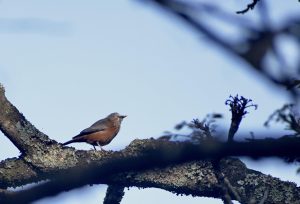 “When Bird Count India asked me if I’d be willing to coordinate the count for Meghalaya, and I was glad to do so.” says an enthusiastic Ezra Rynjah.
“When Bird Count India asked me if I’d be willing to coordinate the count for Meghalaya, and I was glad to do so.” says an enthusiastic Ezra Rynjah.
Explaining his role in the walks, Rynjah says, “As a part of the event, I conducted workshops at three educational institutions – St. Edmund’s College, Union Christian College, and St. Anthony’s College on the 12th, 16th, and 17th of February 2024, respectively. Additionally, I held two public walks on the morning of the 18th and 19th of February 2024.”
Lasting approximately 3 hours, depending on a number of factors, the aims of both the workshops and public walks were the same – first and foremost to introduce the activity of birdwatching to people who had never done it before, and secondly, to instruct people on how to document their observations using eBird and its associated mobile applications like e-Bird and Merlin in the spirit of citizen science.
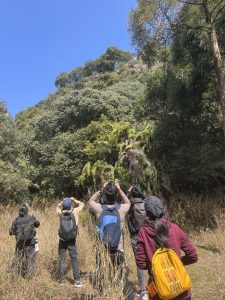 The GBBC/CBC has been conducting bird walks for sometime now and most definitely not a new event, however, as Rynjah explains, he has conceived the activity of birdwatching as a means of re-introducing people to nature, and a way for them to connect with the often overlooked lives that surround them. He further adds, “I’ve seen that people who go out birdwatching end up finding other nature-related interests, whether trees, butterflies or spiders. The important thing is to get out there and observe. I look at these walks and workshops as a chance to provide the opportunity to people to at least try out the activity, to see if it’s something that appeals to them. If not, at least you’ve met some people and had a walk in the woods – hardly a waste of time.”
The GBBC/CBC has been conducting bird walks for sometime now and most definitely not a new event, however, as Rynjah explains, he has conceived the activity of birdwatching as a means of re-introducing people to nature, and a way for them to connect with the often overlooked lives that surround them. He further adds, “I’ve seen that people who go out birdwatching end up finding other nature-related interests, whether trees, butterflies or spiders. The important thing is to get out there and observe. I look at these walks and workshops as a chance to provide the opportunity to people to at least try out the activity, to see if it’s something that appeals to them. If not, at least you’ve met some people and had a walk in the woods – hardly a waste of time.”
Along with other birdwatchers who participated in the event all over Meghalaya, made a total record of 200 species of birds from 9 districts of the state in those four days!
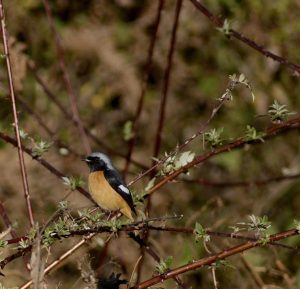 On being asked whether participants in these walks need to bring any gadgets or gear along, Rynjah answers, “I don’t expect participants to bring anything to the workshops or public walks except their curiosity! For the public walks, I currently have two pieces of equipment that I lend out for the duration of the walks. It isn’t a strict requirement for anyone to have their own equipment (although a pair of decent water-proof and fog-proof binoculars is always a sound lifetime investment).”
On being asked whether participants in these walks need to bring any gadgets or gear along, Rynjah answers, “I don’t expect participants to bring anything to the workshops or public walks except their curiosity! For the public walks, I currently have two pieces of equipment that I lend out for the duration of the walks. It isn’t a strict requirement for anyone to have their own equipment (although a pair of decent water-proof and fog-proof binoculars is always a sound lifetime investment).”
Elaborating on what he expects out of the attendees, Rynjah emphasises, “I encourage people to learn to cultivate patience and observation, which are essential while birdwatching. In teaching identification and documentation, I also provide reference materials such as the book “Birds of the Indian Subcontinent” by Grimmett, Inskipp, and Inskipp. That being said, I aim to get more equipment for such events in the future that can also be lent out for research-related purposes.”
Participants were treated to sightings of a wide array of bird species, such as the Spotted Dove, Blue -throated Barbet, Brown Shrike, Chestnut-tailed Starling, Common Myna, Large-billed Crow, Yellow-browed Warbler, Eurasian tree Sparrow, Eurasian Hoopoe, and Pied Flycatchers.
As the workshop drew to a close, participants shared their experiences and insights gained from the day’s activities. Here are a couple of feedbacks from students who participated:
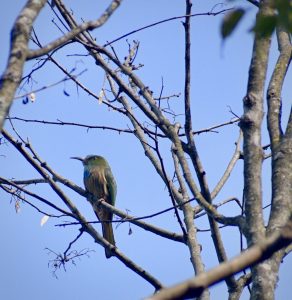 “Under the guidance of Rynjah and the teachers, students learned to identify common bird species and gained insights into their behaviour and ecology, setting the stage for an immersive birding experience.” says Esther Lalhmingmawi Hmar, B.Sc. 6th Semester, Department of Zoology, St. Edmund’s College,
“Under the guidance of Rynjah and the teachers, students learned to identify common bird species and gained insights into their behaviour and ecology, setting the stage for an immersive birding experience.” says Esther Lalhmingmawi Hmar, B.Sc. 6th Semester, Department of Zoology, St. Edmund’s College,
Krish Dutt shares “The workshop helped me understand the significance of bird-watching in conservation. It also helped understand field etiquette and team working skills. My interest in bird watching has intensified due to these experiences. ”
Another participant from the walk, Lamboithem Lhouvum adds, “It was a new and insightful experience. To be honest, I have never paid close attention to the birds flying around us. But through this workshop, I have realised how eye-pleasing, beautiful and unique they are.”
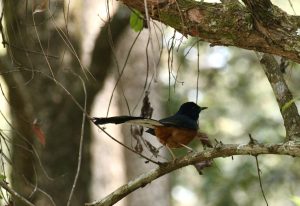 The One-day Birding Workshop at St. Edmund’s College helped in fostering a deeper understanding of birds and their habitats, leaving a lasting impact on both students and faculty, igniting a passion for conservation and ecological stewardship.
The One-day Birding Workshop at St. Edmund’s College helped in fostering a deeper understanding of birds and their habitats, leaving a lasting impact on both students and faculty, igniting a passion for conservation and ecological stewardship.
Serene Rynjah, another attendee at the walk, shared, “This public walk marked my inaugural GBBC experience in Shillong, and I thoroughly enjoyed mingling with fellow bird enthusiasts from the area with seasoned birders and novices alike. As an ecologist, I advocate for more such walks to foster curiosity and awareness about our natural environment and contribute greatly to the ornithology database.”
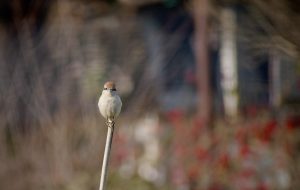 Furthermore, Assistant Professor (English Department’, UCC), Longnam W. Kharpuri articulates, “The Campus Bird Count 2024 was for me an illuminating experience in an exercise I have started a while back in the lockdown periods of 2020. It was also encouraging to see students actively take part in field work and in the practice of identifying birds in the campus. The resource person, Ezra Rynjah, was very helpful and resourceful and we are happy to have had him as a catalyst in the important duty of observing nature in all its beauty and scientific splendour.”
Furthermore, Assistant Professor (English Department’, UCC), Longnam W. Kharpuri articulates, “The Campus Bird Count 2024 was for me an illuminating experience in an exercise I have started a while back in the lockdown periods of 2020. It was also encouraging to see students actively take part in field work and in the practice of identifying birds in the campus. The resource person, Ezra Rynjah, was very helpful and resourceful and we are happy to have had him as a catalyst in the important duty of observing nature in all its beauty and scientific splendour.” Spotting species
Data from ebird.org reveals some of the highest seen avian species in Meghalaya are the Green-winged teal (Common Teal), Indian pied starling (pied myna) and Russet sparrow with areas such as Nongkyllem, WLS as top hotspot, with East Khasi Hills topping the counties.
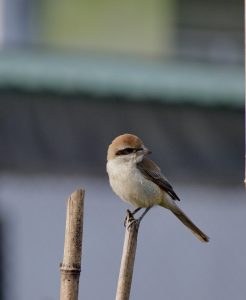 As for the most awaited question – what are some of the migratory species that have been spotted over the season, Rynjah responds, “As of now, there are still some species of wagtail and a few warblers that are winter visitors to our city. We should start to hear different species of cuckoo soon, as the year heads into summer.”
As for the most awaited question – what are some of the migratory species that have been spotted over the season, Rynjah responds, “As of now, there are still some species of wagtail and a few warblers that are winter visitors to our city. We should start to hear different species of cuckoo soon, as the year heads into summer.”
On how many species are spotted, Rynjah states, “That depends on the season, time of day, location, and also luck. In and around Shillong, you can spot anywhere between 10 to 20 species within a one-hour walk including Blue-bearded Bee eater, Long-tailed Broadbill, Daurian Redstart.”
Bird sighting is typically more satisfactory in the warmer months, for obvious reasons but migratory birds are not ruled out and neither are core areas identified by bird enthusiasts.
Elaborating on the choice of walkways for public and a successful sighting, Rynjah notes, “The areas for public walks were planned to be places that would be accessible to people, in terms of distance, and parking space. These spots were also selected on the basis of whether they had a fair diversity of bird species to increase the chances that people see some of the beautiful birds we have in our hills!”
Concerns
As environmental degradation is on the rise with developmental projects inclusive of concretisation as a result of deforestation, natural habitats of most species, birds included, have been affected. Speaking with Rynjah about this, he agrees that the city’s rising traffic, pollution and felling of trees impacted these birds. He articulates, “One can certainly say that there is less space for birds within Shillong than there was in the past and what is there is decreasing at a quickening pace. However, this trend needn’t continue without reflection. We can find a path towards material gain for our city and state while also making space for birds and our other non-human neighbours.”
However, despite being a fast-growing urban landscape, Rynjah believes that it still has a number of green patches within its limits that serve as refugia for many of the species that we find here. These patches include the Itshyrwat reserve forest, the Upper Shillong Reserve Forest, the Short Round Protected Forest, the Riat Khwan Reserve Forest, and the forest that bounds Mawpat, Shyiap, and Langkyrding.
Additionally, the people of this city have always been fond of maintaining gardens that host these birds, although that practice seems to be on the decline now, according to him.
Sharing some of the challenges faced during bird sightings and walks, Rynjah conveys, “In addition to deforestation and land degradation, poaching and illegal trading are definitely considered significant threats to wildlife populations within the conservation community. Something that makes birdwatching particularly challenging in Meghalaya is that the birds are very skittish, having learned to avoid humans or risk death by catapult!”
With 120 attendees over the three workshops and roughly 20 in the public walks in Shillong, all are encouraged to list all bird species seen at a particular location over a period of 15 minutes or more, at any time during the four days, and upload the list to the bird recording platform eBird, which makes checklist creation easier.
A citizen event aimed to promote knowledge among nature lovers and bird enthusiasts, such walks may prove to be therapeutic on many counts – nature, self, and for a congenial community affair.



